文章信息
- 刘佳, 同小娟, 张劲松, 孟平, 李俊, 郑宁
- LIU Jia, TONG Xiaojuan, ZHANG Jinsong, MENG Ping, LI Jun, ZHENG Ning
- 太阳辐射对黄河小浪底人工混交林净生态系统碳交换的影响
- Impacts of solar radiation on net ecosystem carbon exchange in a mixed plantation in the Xiaolangdi Area
- 生态学报, 2014, 34(8): 2118-2127
- Acta Ecologica Sinica, 2014, 34(8): 2118-2127
- http://dx.doi.org/10.5846/stxb201308182105
-
文章历史
- 收稿日期:2013-8-18
- 修订日期:2014-3-20
2. 中国林业科学研究院林业研究所 国家林业局林木培育重点实验室, 北京 100091;
3. 中国科学院地理科学与资源研究所陆地水循环及地表过程重点实验室, 北京 100101
2. Key Laboratory of Tree Breeding and Cultivation of State Forestry Administration, Research Institute of Forestry, Chinese Academy of Forestry, Beijing 100091, China;
3. Key Laboratory of Water Cycle and Related Land Surface Processes, Institute of Geographic Sciences and Natural Resources Research, Chinese Academy of Sciences, Beijing 100101, China
植被-大气间CO2交换研究对准确评价陆地生态系统碳收支有重要意义[1]。在植物生长季节,太阳辐射作为生态系统光合作用碳吸收的驱动力,极大地影响着植物的生长发育[2, 3]。太阳辐射经过大气及云的遮挡和削弱后分为直接辐射和散射辐射,其比例的不同会导致生态系统的气象因子发生变化,从而影响生态系统和大气之间的碳交换过程。太阳辐射、温度和水分是控制陆地生态系统与大气之间的二氧化碳交换的主要环境因子[4, 5]。云作为自然的一种天气要素,强烈影响着近地面的环境状况[6, 7]。云能够改变到达地面的太阳辐射中散射辐射所占有的比例,并且导致了环境中其他因子如:饱和差(VPD)、气温(Ta)和土壤温度的改变,进而显著影响碳交换[8, 9, 10]。
研究表明,散射辐射能够提高生态系统的净碳吸收[3, 11, 12, 13]。Gu等[6]对加拿大寒带白杨林和温带落叶混交林进行了比较研究,结果显示,多云条件下,虽然总光合有效辐射减少,但云的存在导致了散射辐射的增加、气温的降低和水分胁迫的减少,进而减少叶片和土壤呼吸,促进了冠层光合作用,提高了光能利用率和净碳吸收;张弥等[14]在对长白山阔叶红松林的研究中发现,在植被生长旺季,天空有云层覆盖时光合能力比晴朗无云时有所提高,在受一定云层影响的中等太阳辐射条件下有利于该生态系统的碳吸收。云层使得散射辐射增加,气温和湿度降低,植物呼吸作用有所减缓,碳素同化作用增强[3, 10]。Bai等[3]在对高山草原和玉米农田的对比研究中发现,净碳交换(NEE)对光合有效辐射(PAR)的响应在多云天气下比晴朗天气下更加明显。
近年来,大气污染、气溶胶粒子增加等环境问题日趋严重[15]。云层和大气气溶胶含量的变化给地面接收到的直接辐射和散射辐射带来很大影响[16, 17]。我国华北地区的大气环境往往受到西北部地区沙尘的影响。大量滞留在大气中的沙尘,成为对流层气溶胶的主要成分之一,影响地-气系统辐射能收支,从而影响区域的气候及生态环境[18]。近50年来,我国太阳总辐射和直接辐射值以下降趋势为主,而华北区站点下降趋势尤为明显;自2000年以来,散射辐射呈上升趋势[15]。森林是陆地生态系统重要的碳汇。太阳辐射是生态系统进行碳交换的驱动因子,极大地影响着森林生态系统的碳汇大小。研究太阳辐射变化对碳通量的影响有利于加深对碳汇的理解,并为森林碳循环模拟和预测工作的开展奠定了基础。目前,有关太阳辐射对生态系统碳交换的影响主要在温带[10, 19, 20]、亚热带森林[10, 21, 22, 23],在暖温带相关研究则较少。因此,在华北地区开展太阳辐射对森林生态系统净碳交换影响的研究具有重要意义。
本研究利用2006—2008年黄河小浪底人工混交林生长季(6—8月)的碳通量和微气象数据,探究太阳辐射对该生态系统净碳交换(NEE)的影响,揭示太阳辐射和其他环境因子协同变化对该生态系统净碳吸收的影响机制,为区域人工林生态系统碳收支模型的构建与预测提供理论依据和数据支持。
1 研究区概况和研究方法 1.1 研究区概况本研究在国家林业局黄河小浪底森林生态系统定位研究站站(35°01′N、112°28′E,平均海拔高度为410 m)进行。该站位于河南省济源市,处黄河中游流域,紧连太行山,面积7210 hm2。小浪底实验区具有典型的暖温带亚湿润季风气候特征,雨热同季,水热资源较为丰富。年平均气温12.4—14.3 ℃,全年日照时数为2367.7 h,年平均降水量641.7 mm。受季风气候的影响,四季气候分明,降水季节性分配不均匀,6—8月平均降水量为438.0 mm,占全年的68.3%。研究区主要树种为栓皮栎(Quercus variabilis)、侧柏(Platycladus orientalis)、刺槐(Robinia pseudoacacia),林龄分别为32、30和28a,平均株高分别为10.5、8.2和9.3 m。生长季植被叶面积指数(LAI)为6.3。林下灌丛主要有黑枣(Ziziphus jujuba Mill.var. inermis (Bunge) Rehd.)、扁担木(Grewia biloba var. parviflora)、荆条(Vitex negundo L. var)、小叶鼠李(Rhamnus bungeana J.Vass.)等;草本主要有隐子草(Crpsis aculeata (L.) Ait.)、狗尾草(Setaria viridis (L.) Beauv.)。土壤种类主要为棕壤和石灰岩风化母质淋溶性褐土。
1.2 碳通量和微气象观测开路涡度相关观测系统(OPEC)安装在通量塔30 m处。涡度相关系统包括红外CO2/H2O气体分析仪(Model LI-7500,Li-Cor,Nebraska)、三维超声风速仪(Model CAST3,Campbell Scientific Inc.,Logan,Utah)。数据采用CR5000型采集器自动采集(Model CR5000,Campbell Scientific Inc.,Logan,Utah),采样频率为10Hz,记录储存数据,每30 min输出一组平均值。
微气象梯度观测系统包括7层AR-100风速计(Vector Instruments,UK)和7层HMP-45C型温湿度传感器(Vaisala,Finland)(安装高度分别为7、10、11、13、17、24、31 m)。此外,在27 m高度处,安装了CNR-1型净辐射表和CM11型总辐射表(Kipp and Zonen)、Li-190SB型点状光量子表(Li-Cor Inc.,USA)、气压计(Model 52203)和雨量计(Model 52203,RM Young,Inc)等。上述仪器与CR23x型数据采集器(Campbell Sci.,USA)相连,每30 min输出一组平均值。
1.3 数据处理 1.3.1 通量数据处理由于天气状况、大气稳定度等自然因素和仪器响应及供电系统故障等原因,通量观测会有异常数据以及数据缺失的情况发生[24],因此需要对获取的30 min CO2通量数据进行预处理。
本研究采用以下步骤处理和插补每30 min的通量数据:(1)两次坐标旋转;(2)WPL校正因热量和水汽的变化造成空气密度改变的通量数据[25];(3)异常、不合理数据的剔除;(4)对以上经过初步筛选的数据计算出月平均值和方差,与平均值相差超过3倍方差的数值也要剔除掉;(5)利用下列方法插补被去除的数据和缺失的数据:小于2 h的缺失数据用线性内插法插补;白天大于2 h的缺失数据采用平均日变化法(MDV)进行插补[24]。
1.3.2 晴空指数的定义生态系统所接收的散射辐射与云密切相关[26]。通常用晴空指数(kt)来表征云的厚薄[27]。晴空指数kt是云量多少的重要标识。它不仅能反映到达地面的太阳辐射照度,还能反映太阳辐射穿越大气时的状况和太阳辐射受到的影响。当kt接近于0时,代表太阳辐射弱,云层完全覆盖;当kt接近于1时,表示太阳辐射较强,晴朗无云[14]。kt对太阳辐射影响的研究中已被广泛应用[28, 29, 30]。地球水平面上接收的太阳总辐射(S)与地球大气层上方平行于地表面上接收的总太阳辐射(Se)的比率被定义为晴空指数:



式中,Ssc为太阳常数(1370 W/m2),td为日序数,β为太阳高度角,φ为纬度,δ为太阳赤纬,ω为时角。
1.3.3 晴、阴天的界定要确定云量对NEE的影响,就需要界定和辨别晴朗天气。黄河小浪底人工混交林在6—8月处于生长旺季,该时期对应的气候是炎热多雨,完整一天都是晴朗无云天气的情况较少。因此,本文以半天为基础,利用研究期间内晴空指数随太阳高度角的变化及与其正弦值的关系分别对晴朗的上午和下午进行判断[6]。
晴朗的上午或下午的区分主要基于3点: 1)绘制晴空指数随太阳高度角变化的曲线;2)选出晴空指数高于0.45(kt)并随太阳高度角β平滑上升的上午或者下午;3)根据前两步得到的数据,绘制kt随太阳高度角正弦值(sinβ)的变化图,选择晴空指数(kt)和sinβ的曲线能够形成集中散点图的数据,将偏离主要变化趋势的数据排除,确定出晴朗上午或下午[10]。
图 1显示了在晴朗天气条件下,kt和sinβ之间的关系。由图 1可以看出,晴朗的上午和下午的关系存在一种不对称的现象,这和Zhang等[10]在对长白山站点的研究结果类似。下午的曲线位于上午曲线的上方,说明下午晴空指数受太阳高度角正弦的影响更为明显。这可能是由于早晨大气中的水汽和颗粒物较多,影响了晴空指数随太阳高度角的变化。
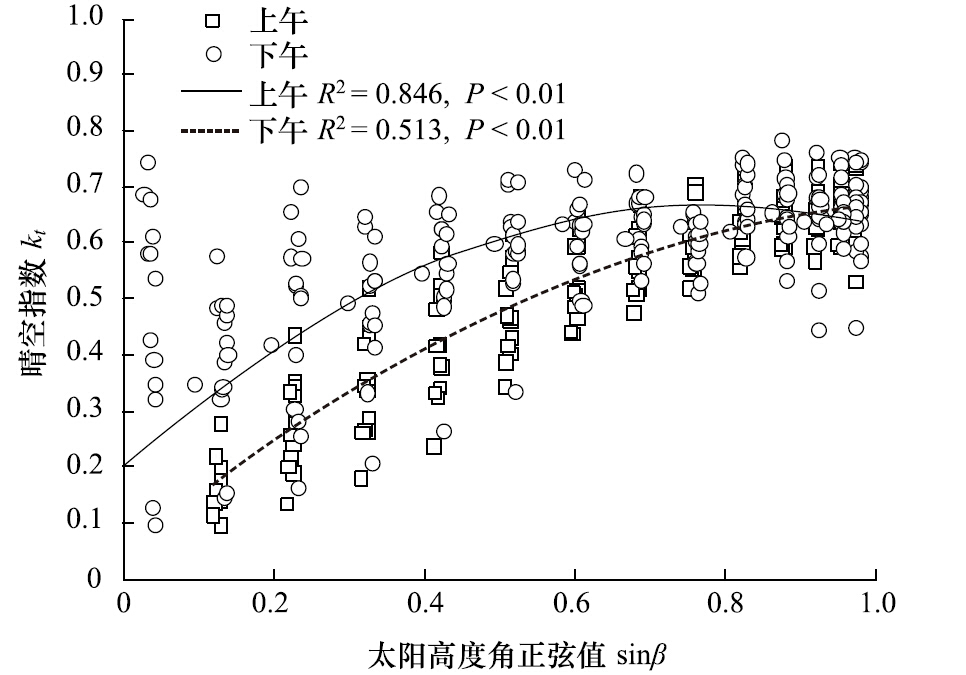
|
| 图1 晴朗天气条件下,晴空指数与太阳高度角正弦的关系 (2006年6—8月) Fig. 1 Relationship between the clearness index (kt) and sine of solar elevation angles under clear sky conditions from June to August in 2006 |
光合有效辐射中的散射辐射可根据晴空指数kt和太阳高度角β的值计算得出[6, 31]:


当0≤kt≤0.3,Sf/Se≤kt时,

当0.3≤kt≤0.78,0.1kt≤Sf/Se≤0.97kt时,

当0.78≤kt,0.1≤kt≤Sf/Se时,

式中,PAR是总光合有效辐射,PARdif是光合有效辐射中的散射辐射,Sf是地球表面接收的总散射辐射(W/m2)。
2 结果分析与讨论 2.1 不同天气条件下NEE对PAR的响应太阳辐射是光合作用的驱动力。本文首先对晴天和多云天气下NEE对PAR的响应进行了研究。NEE对光的响应方程为[32, 33, 34, 35]:

式中,PAR是光合有效辐射(μmol · m-2 · s-1),α是生态系统的初始量子效率(mgCO2/μmol),Pmax为达到光饱和时的最大光合速率(mgCO2 · m-2 · s-1),Re 为白天生态系统的呼吸速率(mgCO2 · m-2 · s-1)。α与Pmax是生态系统植物光合作用特性的两个重要的生理参数。α表示植被对光量子的利用能力,反映了植物对弱光的利用效率[36],Pmax表示植被潜在光合能力[14]。本文中,当NEE是负值时,表示生态系统净吸收CO2,反之为净释放CO2。
云层增加会减少直接辐射,增加散射辐射。与晴天条件相比,多云天气下植被的Pmax比较大[4, 37]。对晴朗天气和多云天气条件下黄河小浪底人工混交林的NEE光响应曲线进行拟合后发现,晴朗天气下NEE的值大于多云天气下的值(图 2)。2006—2008年植物生长旺季,多云天气下的α分别是晴天天气的2.6、1.9和2.2倍;Pmax在多云天气比晴空天气下分别提高了38%、58%和55%(表 1)。这说明天空有云层覆盖时,人工混交林生态系统对弱光的利用效率增强,其光合能力有所提高。
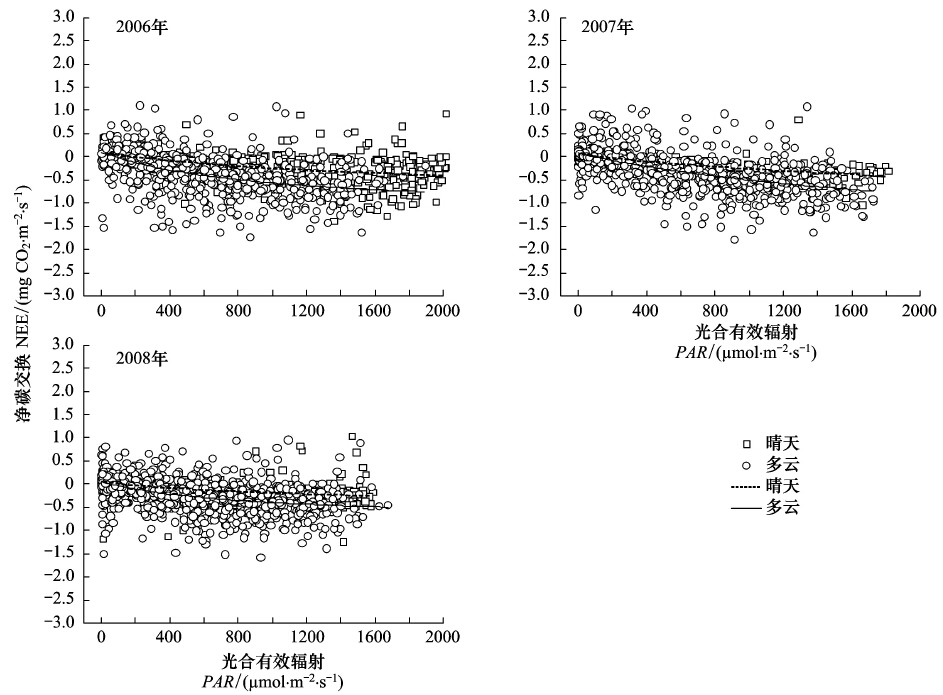
|
| 图2 2006—2008年6—8月人工混交林晴朗天气和多云天气下的光响应曲线 Fig. 2 Light response curves of the mixed plantation in clear and cloudy skies from June to August in the years from 2006 to 2008 |
| 2006 | 2007 | 2008 | ||||
| 多云天气 | 晴朗天气 | 多云天气 | 晴朗天气 | 多云天气 | 晴朗天气 | |
| 初始量子效率α/(μmol/μmol) | 0.031 | 0.012 | 0.019 | 0.010 | 0.022 | 0.010 |
|
最大光合作用速率Pmax/
(mgCO2 · m-2 · s-1) | -1.270 | -0.918 | -1.895 | -1.197 | -0.822 | -0.531 |
| 生态系统呼吸Re/(mgCO2 · m-2 · s-1) | 0.100 | 0.089 | 0.080 | 0.053 | 0.051 | 0.052 |
为了进一步探讨多云对黄河小浪底人工混交林生态系统NEE的影响,本文对NEE随晴空指数的变化进行了分析。晴空指数通常范围是0.05—0.85[3]。本研究选择30°—70°区间的太阳高度角并以5°为间隔将数据进行分组,分别分析太阳辐射对NEE的影响,以消除太阳辐射随太阳高度角变化而对NEE对kt响应的效果[3, 14]。
NEE随kt的变化曲线能够反映出由于云层不同而变化的太阳辐射对森林生态系统净碳交换的影响[14]。在人工混交林生长季,当kt小于0.4时,NEE随kt增加而增加;当kt在0.4—0.5时,NEE达到最大;当kt大于0.5时,NEE随kt增大而减小(图 3)。从表 2中可以看出,2006—2008年人工混交林生态系统生长季NEE达到最大的kt平均值为0.44。这一结果表明,相对于太阳辐射较强的晴朗天气,有一定云层覆盖的中等太阳辐射条件有利于该生态系统对碳的吸收。这一发现与以往的研究一致:在多云条件下,晴空指数kt在0.4—0.7之间时,温带森林生态系统的NEE最大[6, 38, 39];在阿柔草地,当kt落在0.4和0.7之间时,NEE达到其最大值,而盈科玉米农田,kt在0.5—0.7之间时达到最大值[3];Zhang等[10]在云量对长白山和鼎湖山森林生态系统净碳交换影响的研究中发现,kt在0.4—0.6之间时,两个生态系统的NEE达到最大。
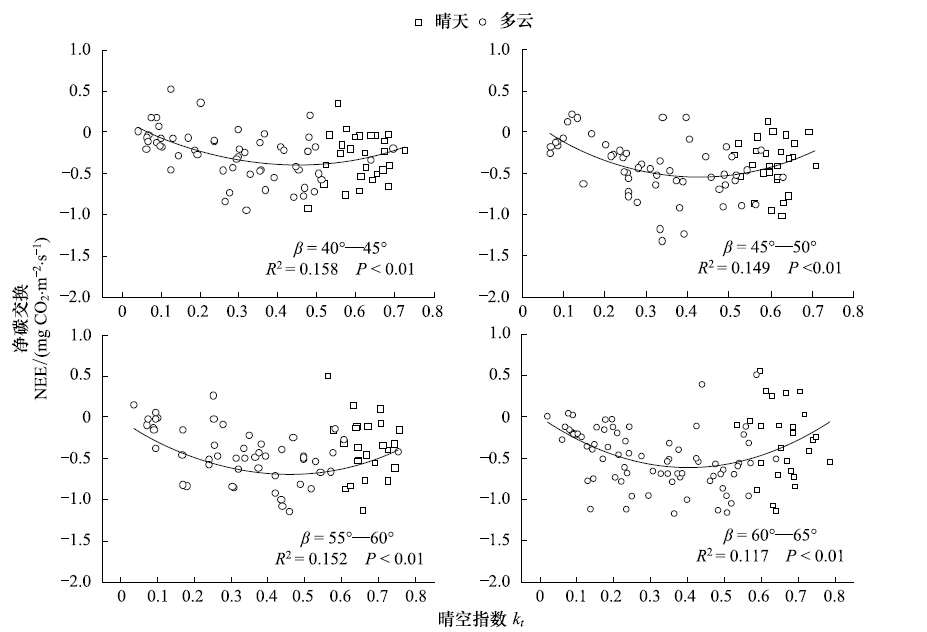
|
| 图3 不同太阳高度角下NEE与晴空指数kt的关系 (以2006年6—8月为例) Fig. 3 Relationship between NEE and the clearness index (kt) for different intervals of solar elevation angles from June to August in 2006 |
|
太阳高度角/(°)
Solar elevation angle (β) | 晴空指数 Clearness index (kt) | ||
| 2006 | 2007 | 2008 | |
| 30—35 | 0.49 | 0.42 | 0.42 |
| 35—40 | 0.40 | 0.41 | 0.39 |
| 40—45 | 0.45 | 0.48 | 0.40 |
| 45—50 | 0.43 | 0.41 | 0.46 |
| 50—55 | 0.45 | 0.53 | 0.43 |
| 55—60 | 0.45 | 0.44 | 0.39 |
| 60—65 | 0.40 | 0.44 | 0.50 |
| 65—70 | 0.42 | 0.51 | 0.38 |
| 平均 Average | 0.44 | 0.46 | 0.42 |
对2006—2008年6—8月黄河小浪底人工混交林生态系统的研究中发现,当kt约为0.44时,NEE达到最大(图 3)。这表明,在有云层覆盖的天气条件下,黄河小浪底人工混交林生态系统净碳吸收最高。
在人工混交林生态系统旺盛生长季(6—8月),由太阳高度角β大于20°时kt的频率分布直方图可以看出,该站晴空指数kt出现频率较高的值为0.3—0.5,并在0.5出现的频率最大(图 4)。而使该生态系统NEE达到最大的晴空指数kt在0.4—0.5之间(图 3)。因此,在植物生长季,该地区的多云天气条件促进了人工混交林生态系统的净碳吸收。

|
| 图4 2006—2008年6—8月晴空指数kt的频率变化分布 Fig. 4 Frequency distributions of the variation of the clearness index (kt) from June to August in the years 2006 to 2008 |
光照是控制NEE的主要因素[21]。温度和饱和差也共同影响着NEE[21]。赵仲辉等[21]在对湖南会同杉木人工林生态系统的研究中发现NEE与PAR、 温度等气象因子存在明显的相关性。在一定太阳高度角下,由于晴阴天的变化,生态系统接收的太阳辐射以及生态系统所接受的散射辐射和直接辐射之间的平衡情况会发生改变。相应地,其他环境因素(如饱和差、气温)也会有所改变。于是,这些变化会影响森林生态系统与大气之间的碳交换过程。研究表明,天空云量增多导致太阳辐射减弱,此时散射辐射在总辐射中所占的比例增加,这样会使更多的光穿过冠层上部达到下部[38],叶片之间光分布更加平衡,提高了下层遮阴叶片的光合作用能力,进而增加了生态系统净碳吸收[6, 10, 40]。
图 5显示了研究站点总光合有效辐射(PAR)以及光合有效辐射中的散射辐射(PARdif)和晴空指数(kt)的关系。总光合有效辐射随晴空指数的升高几乎成直线增加。然而,光合有效辐射中的散射辐射与晴空指数的关系却是非线性的。光合有效辐射中的散射辐射一般是先随晴空指数的增加而增加,当晴空指数在0.4—0.5之间的时候达到最大值,这与该站点NEE达到最大时,生态系统所接收的散射有效辐射的范围相一致(图 3,图 5)。这一结果表明,在多云天气下,黄河小浪底人工混交林生态系统的净碳吸收随着散射辐射的增加而增加。
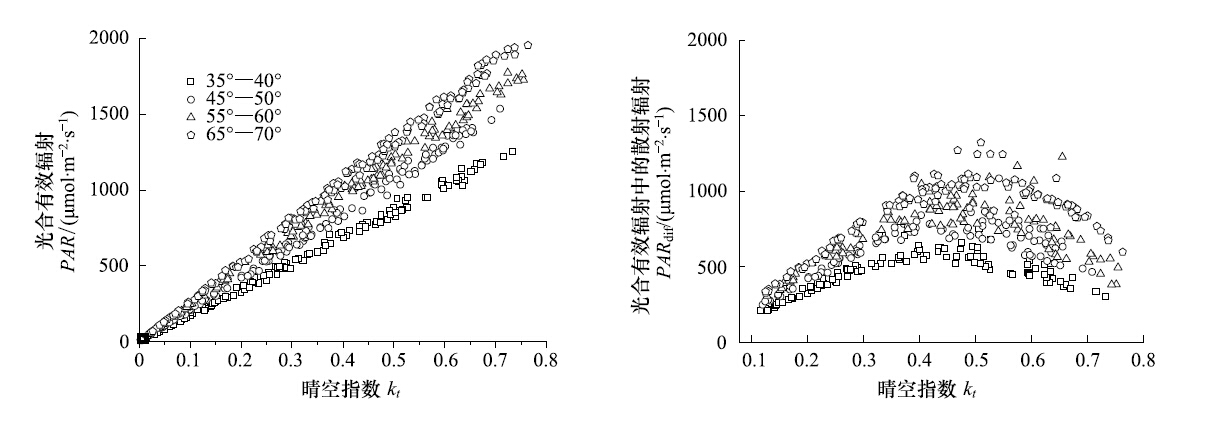
|
| 图5 在选定的太阳高度角范围内,2006年6-8月总光合有效辐射 (PAR) 和光合有效辐射散射辐射 (PARdif) 随晴空指数kt的变化 Fig. 5 Changes in total PAR and diffuse PAR with the clearness index (kt) for selected intervals of solar elevation angle from June to August in 2006 |
VPD是影响陆地生态系统与大气间碳交换的重要因子之一[3, 41]。VPD通过影响气孔导度来影响生态系统与大气间碳和能量的交换过程[42, 43]。VPD的降低可诱导气孔开放,从而提高叶片光合作用[44]。通常,植物的光合速率会随着饱和差的升高而下降[45]。因此,多云天气条件下较小的VPD提高了生态系统的光合作用[46],促进了人工混交林的净碳吸收 (图 2和图 6)。
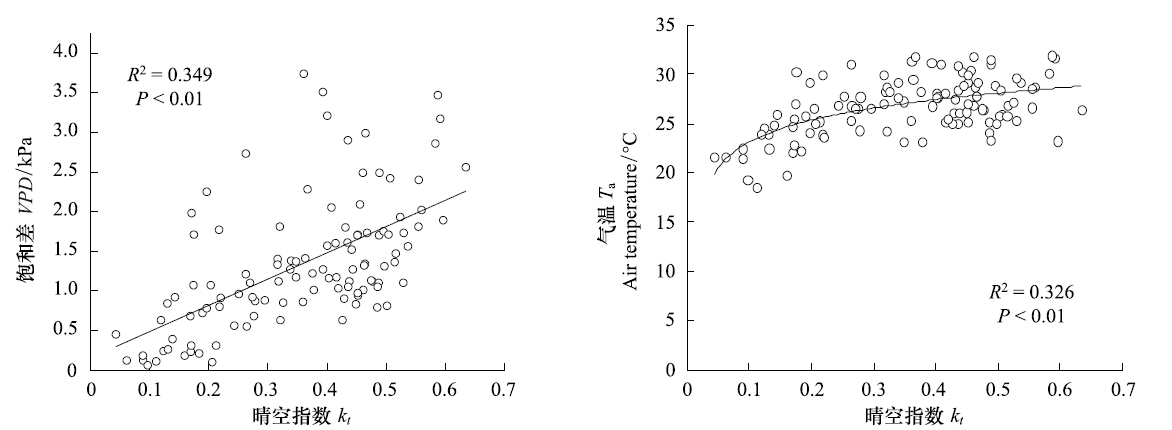
|
| 图6 在一定的太阳高度角范围内 (50°—55°) ,饱和差 (VPD) 、气温 (Ta) 与kt的关系 (以2008年6—8月为例) Fig. 6 Changes in vapor pressure deficit (VPD) and air temperature with the clearness index (kt) for selected intervals of solar elevation angle (50°—55°) in the mixed plantation from June to August in 2008 |
温度是控制生态系统呼吸过程的主要因素之一[47, 48, 49]。在一定的太阳高度角范围内,人工混交林生态系统出现了气温(Ta)随着晴空指数kt降低而下降的情况(图 6)。这表明多云天气情况下气温下降会导致该生态系统呼吸作用的减少。
3 结论本研究利用涡度相关法研究了太阳辐射对黄河小浪底人工混交林净生态系统碳交换NEE的影响,得出的主要结论为:
(1) 与晴朗天气相比,人工混交林生态系统在多云天气条件下净碳交换会增加。主要是由于:多云天气条件下,PARdif的增加。由于散射辐射在林冠中具有更强的透射性,对冠层内叶下的光合作用有促进作用。此外,晴天天气条件下,强烈的直接辐射会使得植被光合作用出现光饱和现象,从而抑制了光合速率的提升。
(2) kt小于0.44时,人工混交林生态系统净碳交换量一开始随着晴空指数增加。当kt大于0.44时,净碳交换量则随kt的增加而下降。多云条件下,气温和饱和差的下降促进了冠层光合作用,减少了呼吸作用。因此,在有云覆盖的天气条件下,VPD和气温的降低是黄河小浪底人工混交林生态系统净碳交换增加的另一个主要原因。
| [1] | Wu J B, Guan D X, Zhang M, Han S J, Yu G R, Sun X M. Carbon budget characteristics of the broadleaved Korean pine forests in Changbaishan Mountains. Journal of Beijing Forestry University, 2007, 29(1): 1-6. |
| [2] | Guan D X, Wu J B, Zhao X S, Han S J, Yu G R, Sun X M, Jin C J. CO2 fluxes over an old, temperate mixed forest in northeastern China. Agricultural and Forest Meteorology, 2006, 137(3/4): 138-149. |
| [3] | Bai Y F, Wang J, Zhang B C, Zhang Z H, Liang Ji. Comparing the impact of cloudiness on carbon dioxide exchange in a grassland and a maize cropland in northwestern China. Ecological Research, 2012, 27(3): 615-623. |
| [4] | Law B E, Falge E, Gu L H, Baldocchi D, Pakwin P, Berbigier P, Davis K, Dolman A J, Falk M, Fuentes J D, Goldstein A, Granier A, Grelle A, Hollinger D, Janssens I A, Jarvis P, Jensen N O, Katul G, Mahli Y, Matteucci G, Meyers T, Monson R, Munger W, Oechel W, Olson R, Pilegaard K, Paw K T, Thorgeirsson H, Valentini R, Verma S, Vesala T, Wilson K, Wofsy S. Environmental controls over carbon dioxide and water vapor exchange of terrestrial vegetation. Agricultural and Forest Meteorology, 2002, 113(1/4): 97-120. |
| [5] | Baldocchi D. “Breathing” of the terrestrial biosphere: lessons learned from a global network of carbon dioxide flux measurement systems. Australian Journal of Botany, 2008, 56(1): 1-26. |
| [6] | Gu L H, Fuentes J D, Shugart H H, Staebler R M, Black T A. Responses of net ecosystem exchanges of carbon dioxide to changes in cloudiness: results from two North American deciduous forests. Journal of Geophysical Research-Atmospheres, 1999, 104(D24): 31421-31434. |
| [7] | Bar-Or R Z, Koren I, Altaratz O. Estimating cloud field coverage using morphological analysis. Environmental Research Letters, 2010, 5(1): 1-6. |
| [8] | Zhao L, Li Y N, Xu S X, Zhou H K, Gu S, Yu G R, Zhao X Q. Diurnal, seasonal and annual variation in net ecosystem CO2 exchange of an alpine shrubland on Qinghai-Tibetan plateau. Global Change Biology, 2006, 12(10): 1940-1953. |
| [9] | Aires L M I, Pio C A, Pereira J S. Carbon dioxide exchange above a Mediterranean C3/C4 grassland during two climatologically contrasting years. Global Change Biology, 2008, 14(3): 539-555. |
| [10] | Zhang M, Yu G R, Zhang L M, Sun X M, Wen X F, Han S J, Yan J H. Impact of cloudiness on net ecosystem exchange of carbon dioxide in different types of forest ecosystems in China. Biogeosciences, 2010, 7(2): 711-722. |
| [11] | Gu L H, Baldocchi D, Wofsy S, Munger J, Michalsky J, Urbanski S, Boden T. Response of a deciduous forest to the Mount Pinatubo eruption: enhanced photosynthesis. Science, 2003, 299(5615): 2035-2038. |
| [12] | Sun J S, Zhou G S. Review of advances in measurements and effects of diffuse radiation on terrestrial ecosystem productivity. Chinese Journal of Plant Ecology, 2010, 34(4): 452-461. |
| [13] | Ren Y F, Wang C Y, Zhao Y X. Review on impact of atmospheric aerosol radiation effect on crops and ecological system. Chinese Journal of Agrometeorology, 2010, 31(4): 233-540. |
| [14] | Zhang M, Yu G R, Zhang L M, Sun X M, Wen X F, Han S J. Effects of solar radiation on net ecosystem exchange of broadleaved-korean pine mixed forest in Changbai Mountain, China. Journal of Plant Ecology: Chinese Version, 2009, 33(2): 270-282. |
| [15] | Ma J Y, Liang H, Luo Y, Li S K. Variation trend of direct and diffuse radiation in China over recent 50 years. Acta Physica Sinica, 2011, 60(6): 853-866. |
| [16] | Niyogi D, Chang H I, Saxena V K, Holt T, Alapaty K, Booker F, Chen F, Davis K J, Holben B, Matsui T, Meyers T, Oechel W C, Pielke R A, Well R, Wilson K, Xue Y K. Direct observations of the effects of aerosol loading on net ecosystem CO2 exchanges over different landscapes. Geophysical Research Letters, 2004, 31(20), L20506, doi: 10.1029/2004GL020915. |
| [17] | Min Q L. Impacts of aerosols and clouds on forest-atmosphere carbon exchange. Journal of Geophysical Research-Atmospheres, 2005, 110(D6): D06203, doi: 10.1029/2004JD004858. |
| [18] | Jia X, Wang W C, Chen Y H, Huang J P, Chen J M, Zhang H, Bai H T, Zhang P. Influence of dust aerosols on cloud radiative forcing over Northern China. China Environmental Science, 2010, 30(8): 1009-1014. |
| [19] | Zhou L Y, Jia B R, Zeng W, Wang Y, Zhou G S. Net ecosystem CO2 exchange of virgin Larix gmelinii forest and its characteristics of light response. Acta Ecologica Sinica, 2010, 30(24): 6919-6926. |
| [20] | Zhao Z H, Zhang L P, Kang W X, Tian D L, Xiang W H, Yan W D, Peng C H. Characteristics of CO2 flux in a Chinese fir plantation ecosystem in Huitong County, Hunan Province. Scientia Silvae Sinicae, 2011, 47(11): 6-12. |
| [21] | Liu Y F, Yu G R, Wen X F, Wang Y H, Song X, Li J, Sun X M, Yang F T, Chen Y R, Liu Q J. Seasonal dynamics of CO2 fluxes from subtropical plantation coniferous ecosystem. Science in China Series D: Earth Sciences, 2006, 49(S2): 99-109. |
| [22] | Peng Z H, Wang Y, Ren H Q, Sun Q X, Zhou J X. Research on the variation of carbon flux and the relationship of environmental factors and carbon flux of populus forest ecosystem in the reaches of Yangtze river in Anqing. Forest Research, 2009, 22(2): 237-242. |
| [23] | Jiang Y, Hu H B, Zhang X S, Xue J H. The carbon flux and its environmental factors in a north subtropical secondary oak forest ecosystem. Journal of Nanjing Forestry University: Natural Science Edition, 2011, 35(3): 38-42. |
| [24] | Falge E, Baldocchi D, Olson R, Anthoni P, Aubinet M, Bernhofer C, Burba G, Ceulemans R, Clement R, Dolman H, Granier A, Gross P, Grunwald T, Hollinger D, Jensen N O, Katul G, Keronen P, Kowalski A, Lai C T, Law B E, Meyers T, Moncrieff H, Moors E, Munger J W, Pilegaard K, Rannik U, Rebmann C, Suyker A, Tenhunen J, Tu K, Verma S, Vesala T, Wilson K, Wofsy S. Gap filling strategies for defensible annual sums of net ecosystem exchange. Agricultural and Forest Meteorology, 2001, 107(1): 43-69. |
| [25] | Webb E K, Pearman G I, Leuning R. Correction of flux measurements for density effects due to heat and water vapour transfer. Quarterly Journal of the Royal Meteorological Society, 1980, 106(447): 85-100. |
| [26] | Shen Y B, Zhao Z C, Shi G Y. The progress in variation of surface solar radiation, factors and probable climatic effects. Advances in Earth Science, 2008, 23(9): 915-923. |
| [27] | Fan Y Z, Zhang X Z, Shi P L. Influence of diffuse radiation on the net CO2 exchange of alpine meadow ecosystem on Tibet Plateau. Geographical Research, 2009, 28(6): 1673-1681. |
| [28] | Tsubo M, Walker S. Relationships between photosynthetically active radiation and clearness index at Bloemfontein, South Africa. Theoretical and Applied Climatology, 2005, 80(1): 17-25. |
| [29] | Woyte A, Belmans R, Nijs J. Fluctuations in instantaneous clearness index: analysis and statistics. Solar Energy, 2007, 81(2): 195-206. |
| [30] | Okogbue E C, Adedokun J A, Holmgren B. Hourly and daily clearness index and diffuse fraction at a tropical station, Ile-Ife, Nigeria. International Journal of Climatology, 2009, 29(8): 1035-1047. |
| [31] | Reindl D T, Beckman W A, Duffie J A. Diffuse fraction correlations. Solar Energy, 1990, 45(1): 1-7. |
| [32] | Greco S, Baldocchi D D. Seasonal variations of CO2 and water vapour exchange rates over a temperate deciduous forest. Global Change Biology, 1996, 2(3): 183-197. |
| [33] | Song X, Liu Y F, Xu X F, Yu G R, Wen X F. Comparison study on carbon dioxide, water and heat fluxes of the forest ecosystem in red earth hilly zone over winter and spring. Resource Science, 2004, 26(3): 97-104. |
| [34] | Pilegaard K, Hummelsh J P, Jensen NO, Chen Z. Two years of continuous CO2 eddy-flux measurements over a Danish beech forest. Agricultural and Forest Meteorology, 2001, 107(1): 29-41. |
| [35] | Wang H M, Saigusa N, Yamamoto S, Kondo H, Hirano T, Toriyama A, Fujinuma Y. Net ecosystem CO2 exchange over a larch forest in Hokkaido, Japan. Atmospheric Environment, 2004, 38(40): 7021-7032. |
| [36] | Tong X J, Zhang J S, Meng P, Yi C J, Gao J, Huang H, Guo L. Relationship between net ecosystem carbon exchange and meteorological factors in a plantation in the hilly area of the North China. Acta Ecologica Sinica, 2009, 29(12): 6638-6645. |
| [37] | Goulden M L, Daube B C, Fan S M, Sutton D J, Bazzaz A, Munger J W, Wofsy S. Physiological responses of a black spruce forest to weather. Journal of Geophysical Research, 1997, 102(D24): 28987-28996. |
| [38] | Letts M G, Lafleur P M, Roulet N T. On the relationship between cloudiness and net ecosystem carbon dioxide exchange in a peatland ecosystem. Ecoscience, 2005, 12(1): 53-59. |
| [39] | Urban O, Janou D, Acosta M, Czern y ′ R, Marková I, Navrátil M, Pavelka M, Pokorn y ′ R, prtová M, Zhang R, punda V, Grace J, Marek M V. Ecophysiological controls over the net ecosystem exchange of mountain spruce stand. Comparison of the response in direct vs. diffuse solar radiation. Global Change Biology, 2007, 13(1): 157-168. |
| [40] | Alton P B. Reduced carbon sequestration in terrestrial ecosystems under overcast skies compared to clear skies. Agricultural and Forest Meteorology, 2008, 148(10): 1641-1653. |
| [41] | Leuning R. A critical appraisal of a combined stomatal-photosynthesis model for C3 plant. Plant, Cell & Environment, 1995, 18(4): 339-355. |
| [42] | Bunce J A. Direct and acclimatory responses of stomatal conductance to elevated carbon dioxide in four herbaceous crop species in the field. Global Change Biology, 2001, 7(3): 323-331. |
| [43] | Damour G, Simonneau T, Cochard H, Urban L. An overview of models of stomatal conductance at the leaf level. Plant, Cell & Environment, 2010, 33(9): 1419-1438. |
| [44] | Collatz G J, Ball J T, Grivet C, Berry J A. Physiological and environmental regulation of stomatal conductance, photosynthesis and transpiration: A model that includes a laminar boundary layer. Agricultural and Forest Meteorology, 1991, 54(2/4): 107-136. |
| [45] | Cunningham S C. Photosynthetic responses to vapour pressure deficit in temperate and tropical evergreen rainforest trees of Australia. Oecologia, 2005, 142(4): 521-528. |
| [46] | Freedman J M, Fitzjarrald D R, Moore K E, Sakai R K. Boundary layer cloud climatology and enhanced forest-atmosphere exchange // The 23rd Conference on Agricultural and Forest Meteorology. Boston: American Meteorological Society, 1998: 41-44. |
| [47] | Raich J W, Schlesinger W H. The global carbon dioxide flux in soil respiration and its relationship to vegetation and climate. Tellus B, 1992, 44(2): 81-89. |
| [48] | Guan D X, Wu J B, Yu G R, Zhao X S, Han S J, Jin C J. Meteorological control on CO2 flux above broad-leaved Korean pine mixed forest in Changbai Mountains. Science in China Series D: Earth Sciences, 2005, 48(S1): 116-122. |
| [49] | Shi P L, Sun X M, Xu L L, Zhang X Z, He Y T, Zhang D Q, Yu G R. Net ecosystem CO2 exchange and controlling factors in a steppe-Kobresia meadow on the Tibetan Plateau. Science in China Series D: Earth Sciences, 2006, 49(S2): 207-218. |
| [1] | 吴家兵, 关德新, 张弥, 韩士杰, 于贵瑞, 孙晓敏. 长白山阔叶红松林碳收支特征. 北京林业大学学报, 2007, 29(1): 1-6. |
| [12] | 孙敬松, 周广胜. 散射辐射测量及其对陆地生态系统生产力影响的研究进展. 植物生态学报, 2010, 34(4): 452-461. |
| [13] | 任义方, 王春乙, 赵艳霞. 气溶胶辐射效应对作物及生态系统的影响综述. 中国农业气象, 2010, 31(4): 233-540. |
| [14] | 张弥, 于贵瑞, 张雷明, 孙晓敏, 温学发, 韩士杰. 太阳辐射对长白山阔叶红松林净生态系统碳交换的影响. 植物生态学报, 2009, 33(2): 270-282. |
| [15] | 马金玉, 梁宏, 罗勇, 李世奎. 中国近50年太阳直接辐射和散射辐射变化趋势特征. 物理学报, 2011, 60(6): 853-866. |
| [18] | 贾璇, 王文彩, 陈勇航, 黄建平, 陈建民, 张华, 白鸿涛, 张萍. 华北地区沙尘气溶胶对云辐射强迫的影响. 中国环境科学, 2011, 30(8): 1009-1014. |
| [19] | 周丽艳, 贾丙瑞, 曾伟, 王宇, 周广胜. 原始兴安落叶松林生长季净生态系统CO2交换及其光响应特征. 生态学报, 2010, 30(24): 6919-6926. |
| [20] | 赵仲辉, 张利平, 康文星, 田大伦, 项文化, 闫文德, 彭长辉. 湖南会同杉木人工林生态系统CO2通量特征. 林业科学, 2011, 47(11): 6-12. |
| [21] | 刘允芬, 于贵瑞, 温学发, 王迎红, 宋霞, 李菊, 孙晓敏, 杨风亭, 陈永瑞, 刘琪璟. 千烟洲中亚热带人工林生态系统CO2通量的季节变异特征. 中国科学 D辑: 地球科学, 2006, 36(增刊I): 91-102. |
| [22] | 彭镇华, 王妍, 任海青, 孙启祥, 周金星. 安庆杨树林生态系统碳通量及其影响因子研究. 林业科学研究, 2009, 22(2): 237-242. |
| [23] | 蒋琰, 胡海波, 张学仕, 薛建辉. 北亚热带次生栎林碳通量及其影响因子研究. 南京林业大学学报: 自然科学版, 2011, 35(3): 38-42. |
| [26] | 申彦波, 赵宗慈, 石广玉. 地面太阳辐射的变化、影响因子及其可能的气候效应最新研究进展. 地球科学进展, 2008, 23(9): 915-923. |
| [27] | 范玉枝, 张宪洲, 石培礼. 散射辐射对西藏高原高寒草甸净生态系统CO2交换的影响. 地理研究, 2009, 28(6): 1673-1681. |
| [33] | 宋霞, 刘允芬, 徐小锋, 于贵瑞, 温学发. 红壤丘陵区人工林冬春时段碳、水、热通量的观测与分析. 资源科学, 2004, 26(3): 96-104. |
| [36] | 同小娟, 张劲松, 孟平, 尹昌君, 高峻, 黄辉, 国琳. 华北低丘山地人工林生态系统净碳交换与气象因子的关系. 生态学报, 2009, 29(12): 6638-6645. |
| [48] | 关德新, 吴家兵, 于贵瑞, 赵晓松, 韩士杰, 金昌杰. 气象条件对长白山阔叶红松林CO2通量的影响. 中国科学D辑: 地球科学, 2004, 34(增刊Ⅱ): 103-108. |
| [49] | 石培礼, 孙晓敏, 徐玲玲, 张宪洲, 何永涛, 张东秋, 于贵瑞. 西藏高原草原化嵩草草甸生态系统CO2净交换及其影响因子. 中国科学, 2006, 36(增刊I): 194-203. |
 2014, Vol. 34
2014, Vol. 34




